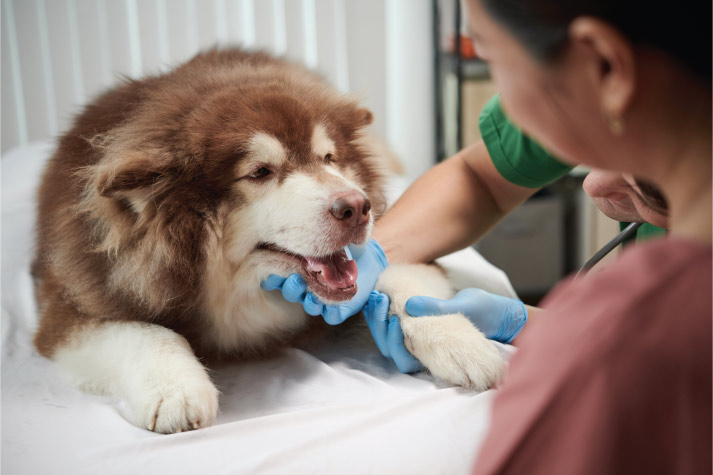
16 Apr
What are the Symptoms of Rabies in Pets?
Rabies is a dangerous but preventable viral disease which is commonly transmitted through animal bites from an infected animal. The rabies virus affects the central nervous system of animals, culminating in disease, brain damage, and eventual death. While any mammal can be infected with rabies, wild animals like bats, raccoons, foxes, stray dogs, and stray cats account for most cases.
Here Is Everything You Need to Know About Rabies in Pets
How Does the Rabies Virus Travel?
The rabies virus infects the body through a bite from another infected animal. The virus then travels from the bite site to the brain by travelling through the nervous system. During this period, the animal does not appear ill or show symptoms of rabies. The infected animal typically passes away within a week of becoming sick and showing symptoms, and since the virus is fatal for humans as well, it is important to understand the transmission of the disease so it can be mitigated.
The rabies virus is transmitted through direct contact with a rabid animal's saliva with broken or cut skin. Exposure through bites is the most common form of exposure to rabies. Scratches, wounds, abrasions, bruises, or cuts that are exposed to the saliva or infected tissue of a rabid animal are all responsible for the transmission of the rabies virus. Other means of transmission are possible, but these are extremely rare, such as in cases of organ transplants.
In the later stages of the disease, the virus reaches the animal’s brain and multiplies, which leads to inflammation in the brain. This period is when symptoms first appear, and once symptoms have appeared, the virus has harmed the brain enough to show very obvious signs of rabid behaviour. After this point, the disease can be transmitted through a bite and salivary transmission.
Signs and Symptoms of Rabies
The period between the animal bite and symptoms showing up is known as the incubation period; this period can last from a few weeks to a few months. During this period, the animal cannot transmit rabies to others since the virus has not reached the saliva. This is the early stage of the disease.
The incubation period for rabies varies tremendously. This is because multiple factors determine the incubation period, such as the bite area, site of exposure, any pre-existing immunity in the person/animal, and so on. The earliest symptoms of a rabies infection resemble the flu, including weakness, discomfort, or headaches. An itch or prickly sensation around the bit may be noticeable during this period; these symptoms can last for days.
As the disease progresses, hallucinations, delusions, hydrophobia, and insomnia can all be observed in the patient. Once these symptoms of rabies appear, the disease is nearly always fatal, with treatment being supportive rather than curing the disease. For example, hydrophobia demonstrates that the disease has progressed up the central nervous system.
As for symptoms of rabies in animals, infected animals usually exhibit similar symptoms to humans infected by rabies. These include more generalized or flu-like symptoms, neurological symptoms, erratic or aggressive behaviour, and eventual death.
How to Prevent Rabies
In Pets:
- Schedule regular vet visits and get your pet vaccinated against rabies.
- Supervise your pets to ensure they do not interact with a stray or rabid animal.
- Get your pet spayed/neutered to reduce the chance of interaction with stray animals.
- Contact the local authorities to report stray animals so they can be vaccinated against rabies and other infectious diseases.
In Humans:
- Leave all wild animals alone. No reason to interact whatsoever.
- Recognize the risk and raise awareness among your loved ones.
- Clean and disinfect any animal scratches or bites immediately.
- Head to a doctor, clinic, or hospital to get your bite/scratch examined. Rabies is fatal but completely preventable. With postexposure prophylaxis and medical attention, rabies is 100% preventable.
- Vaccinate your pet, preferably with a rabies vaccine with a longer protection term (3 years)
How Can Rabies be Diagnosed?
Rabies can be diagnosed using a direct fluorescent antibody test (DFA test) in animals. This test looks for rabies virus antigens in brain tissue. In humans, several tests are required for the same. Laboratory tests at a laboratory diagnostic can save time and effort. Due to the dangerous nature of a rabies infection, laboratory tests are often standardized, reliable, and quick.
Rabies Titer Test for International Pet Travel
A rabies vaccine is an essential requirement for international pet travel. Since no country wants its ecosystem to be infected by diseases from animals that are being imported, you should always vaccinate your pet before travelling.
A rabies titer test is sometimes required to ensure your pet has been vaccinated against rabies and has the necessary level of protection to prevent re-infection. Rabies titer tests are conducted by blood testing labs. The process of sample extraction, submission, testing, and results can take some time, so make sure to get this done well before your planned date of travel.
To conclude, rabies is an infectious viral disease that can be fatal in both humans and animals once symptoms of the disease are visible. The good news is that rabies is preventable with time attention and care, as postexposure prophylaxis has a 100% prevention rate and will inevitably save lives. Provided you can recognize the signs and administer care to an animal bite promptly, you should have no trouble avoiding this deadly disease.






AUTHOR’S BIO
Carry My Pet
Passionate pet enthusiasts and globetrotters, dedicated to easing furry friends' journeys worldwide. Penning tales of compassion at CarryMyPet, where every relocation is a tail-wagging adventure.